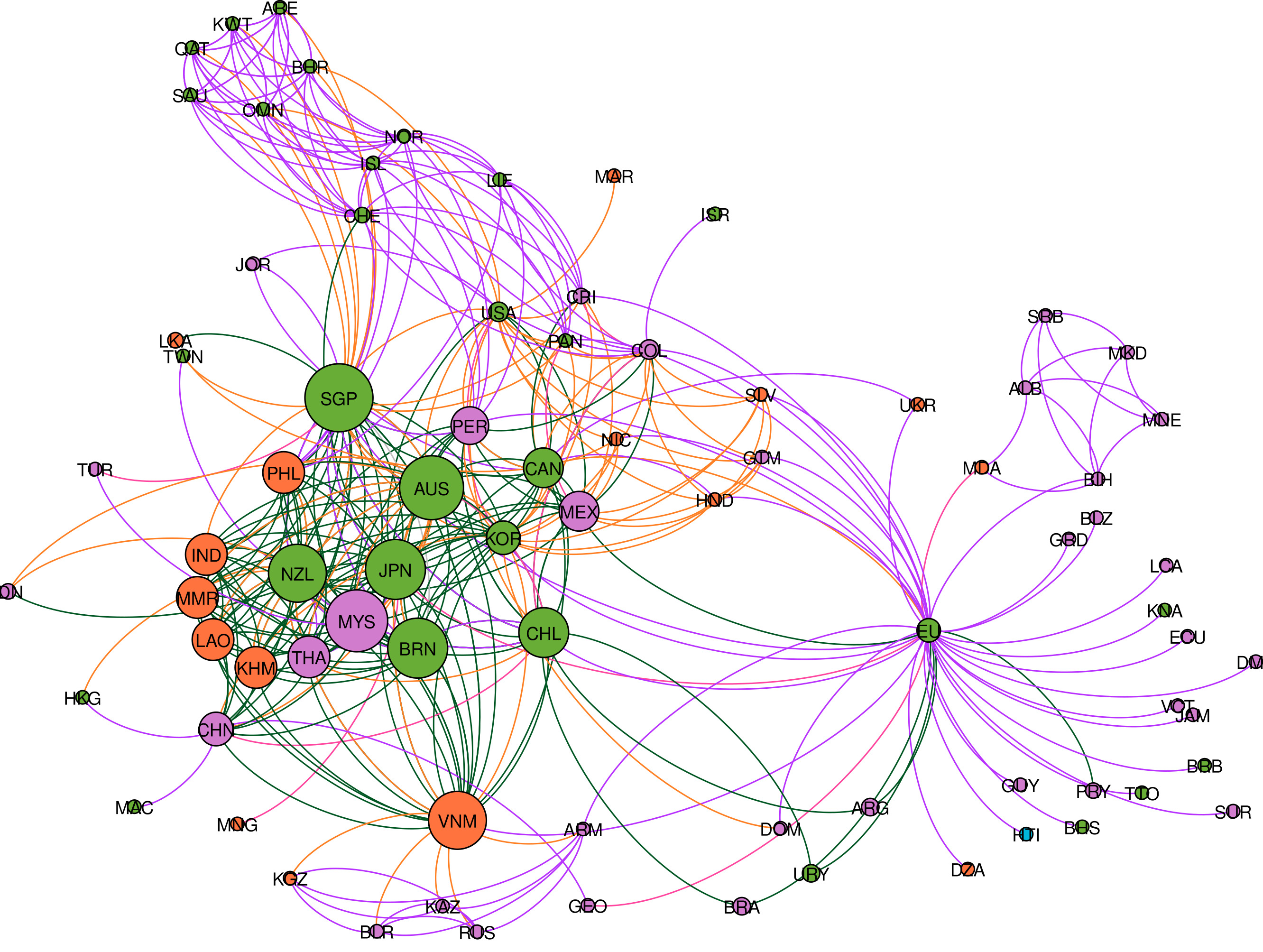The Topology of E-commerce Governance
Global e-commerce is governed by a dense web of preferential trade agreements (PTAs). While the literature on e-commerce governance is growing, our knowledge of the landscape of the e-commerce governance system remains limited.Mapping the current architecture of the system reveals important structural features and properties – such as the degree of fragmentation, polycentricism, and complexity – which can have an impact on system outcomes.
This piece introduces a new working paper that presents a novel network analysis of the architecture of the e-commerce governance regime.
Visualizing the e-commerce governance network
Visualization is one of the draw cards of network analysis as it can reveal important structural attributes of a system in an accessible manner. Figure 1 depicts the e-commerce governance network in 2020 using a force-directed algorithm. Countries are colour coded according to their level of development (green for high income countries, purple for upper-middle income countries, orange for lower-middle countries, and blue for low-income countries). The size of each country’s node is weighted according to the number of trade agreements with e-commerce provisions to which it is party. The ties between countries (i.e. trade agreements) are colour coded based on the scope of their e-commerce or data flow provisions. Agreements with more than 1500 words relating to e-commerce or data flow regulation are coded green, those with between 1000-1500 words are coded black, those with between 500-1000 are coded red, those with less than 500 words are coded purple.
This visualization reveals several interesting and important insights about the structure of the e-commerce governance network in PTAs.
The e-commerce governance system is complex and dominated by a handful of economies.
Complex systems are characterised by a power law distribution of connections. The large node size of a handful of economies indicates that this e-commerce governance system is characterised by a highly unequal distribution of connections and can be considered complex. That the system is complex, rather than merely complicated, has important implications for e-commerce governance in the future as complex systems possess the properties of emergence, adaptation and dynamism. For example, the complex architecture of the e-commerce governance system suggests that innovations in international regulatory cooperation in e-commerce will continue to take place outside the WTO even if e-commerce negotiations at the WTO are successful.
The Asia-Pacific region sits at the centre of the network.
Several Asian economies, particularly Australia, Singapore, and Japan, occupy central positions around which other economies pivot. The European Union serves as another central actor but is mostly disconnected from the rest of the network. The United States and China are both largely peripheral players. It is important to note that if the US re-joined the CPTPP, it would move its structural position closer to the centre of the network.
Regionalism is waning and fragmentation declining.
There is a clear regional flavour to many PTAs with e-commerce provisions. However, the “mega-regional” trade agreements, namely RCEP and CPTPP, shifted the structural gravity towards economies in Asia-Pacific, deepened existing connections, and created new ties. These agreements served to decrease the structural distance between nodes within the system generating a less fragmented architecture
Central states are not tied together.
Several of the most important actors are tightly bound together by comprehensive e-commerce agreements, such as Australia and Singapore via the Digital Economy Agreement. However, most of the central actors are either loosely bound by agreements with shallow e-commerce provisions, such as the EU-Singapore PTA, or are not bound together at all (i.e. the EU and Australia).
Developing countries are largely excluded from the network.
The e-commerce governance network is dominated by high income and high-middle income economies. Lower-middle income countries accounted for 17% of connections despite representing more than a quarter of the entire system. Low-income countries are almost entirely excluded.
The increasing level of structural integration within the e-commerce governance system may bode well for system functioning as norms, rules, and information move more freely throughout the system. At the same time, the emergence of several central countries may pose a challenge to the development of mutually compatible e-commerce regulation. Central countries, due to their privileged structural position, have more capacity to disseminate their preferred regulatory models. Network effects may enhance the position of central states as countries are more likely sign agreements with well-connected partners. When combined with a tendency towards regulatory path dependence, this could result in a system that is characterised by competing or mutually incompatible hubs of e-commerce governance. By the same token, the formation of deep ties between central actors would enhance the prospects of system-level regulatory compatibility. For this reason, the proposed EU-Australia PTA is of systemic importance as it represents an opportunity for two of the system’s key players to tie themselves together and disseminate their mutually agreed upon model to their respective partners.
Nicholas Frank is Associate Lecturer in the School of Politics and International Relations, Australian National University.
The views expressed here are the author’s alone, and do not represent the views of the Institute for International Trade.

This work is licensed under Commons Attribution-NonCommercial-NoDerivatives 4.0 International License.
IIT is a global leader in researching, analysing and commenting on International Trade.
Stay informed about our up-and-coming seminars, events, publications, awards, new projects and collaborations, and other exciting news.

